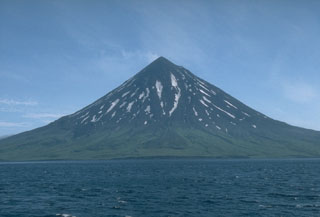Report on Cleveland (United States) — 15 February-21 February 2012
Smithsonian Institution / US Geological Survey
Weekly Volcanic Activity Report, 15 February-21 February 2012
Managing Editor: Sally Sennert.
Please cite this report as:
Global Volcanism Program, 2012. Report on Cleveland (United States) (Sennert, S, ed.). Weekly Volcanic Activity Report, 15 February-21 February 2012. Smithsonian Institution and US Geological Survey.
Cleveland
United States
52.825°N, 169.944°W; summit elev. 1730 m
All times are local (unless otherwise noted)
AVO reported that during 15-18 and 20-21 February no observations of elevated surface temperatures or ash emissions from Cleveland were noted. On 17 February, AVO reported that partly-cloudy satellite observations over the past week revealed that the lava dome had grown to about 60 m in diameter. On 19 February an elevated surface temperature was detected in satellite images. The Volcano Alert Level remained at Watch and the Aviation Color Code remained at Orange. No current seismic information was available because Cleveland does not have a real-time seismic network.
Geological Summary. The symmetrical Mount Cleveland stratovolcano is situated at the western end of the uninhabited Chuginadak Island. It lies SE across Carlisle Pass strait from Carlisle volcano and NE across Chuginadak Pass strait from Herbert volcano. Joined to the rest of Chuginadak Island by a low isthmus, The native name, Chuginadak, refers to the Aleut goddess of fire, who was thought to reside on the volcano. Numerous large lava flows descend the steep-sided flanks. It is possible that some 18th-to-19th century eruptions attributed to Carlisle should be ascribed to Cleveland (Miller et al., 1998). In 1944 it produced the only known fatality from an Aleutian eruption.
Source: US Geological Survey Alaska Volcano Observatory (AVO)

